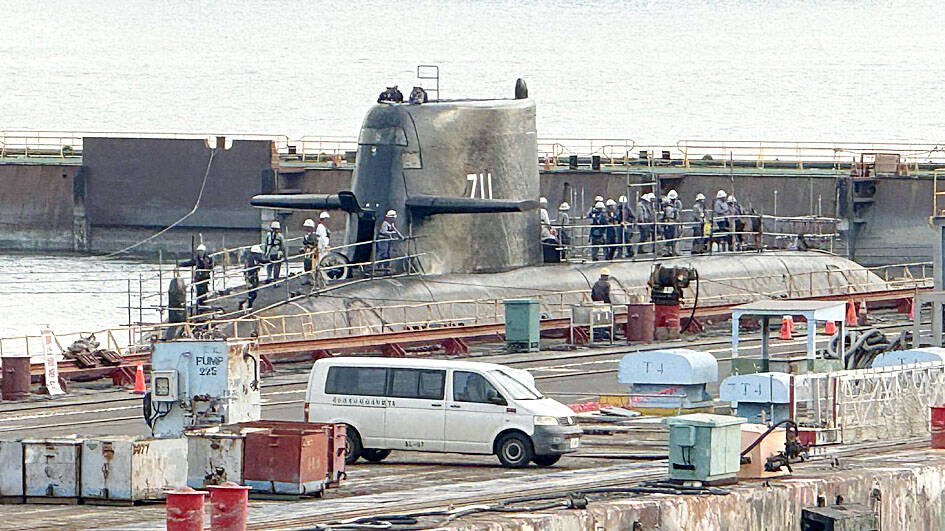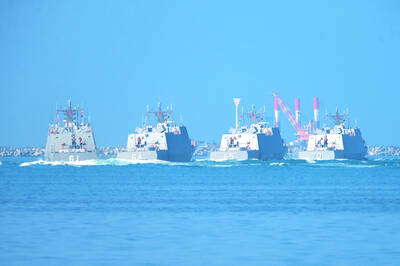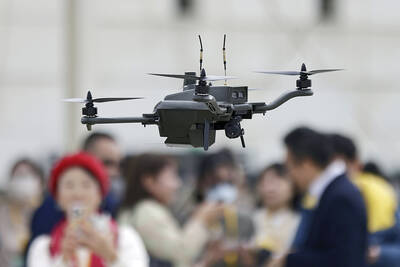Taiwan’s first indigenous defense submarine on Tuesday was moved out of a dry dock to Pier 91 at Kaohsiung Harbor, with the vessel expected to start preparing to undergo diving tests, although the shipbuilder refused to comment on the matter other than to say that everything was proceeding according to plan.
The Hai Kun (海鯤, or Narwhal) has been through sea trials while based at CSBC Corp, Taiwan’s (台灣國際造船) shipyard, and sources said that the move to Pier 91 was to facilitate submergence trials before the end of this month, with delivery to the navy scheduled for November.
However, CSBC had no comment on the activity.

Photo courtesy of a reader
The shipbuilder previously said that the Hai Kun had completed at-sea systems tests, including periscope function, during the third phase of sea trials.
System parameters would be adjusted based on trial data, it said.
CSBC also conducted hyperbaric tests and underwater systems calibrations after the third phase of testing and before the submarine was moved to the dry dock on July 8.
The submarine, a prototype of a planned fleet of indigenous vessels, conducted its first tests starting on June 17, involving propulsion, steering, power systems, ventilation, telecoms and navigation instruments, CSBC said.
On June 26, it underwent a second round of tests, focusing on at-sea systems integration, vessel controls and operational capabilities, the company said.
The move to Pier 91 came as CSBC prepares for a new chairman, with board member Chen Cheng-hung (陳政宏) tapped for the job.
Huang Cheng-hung (黃正弘) last week resigned as chairman, citing family reasons. He is to take up a lecturing role at National Cheng Kung University.
Meanwhile, the CSBC Endeavor Manta, the company’s and the nation’s first military-grade uncrewed surface vehicle (USV), was seen in the area as the Hai Kun was moved on Tuesday.
Whether the USV was on patrol or conducting tests was unknown.
The USV uses a trimaran hull for better balance in choppy seas. It is 8.6m long and 3.7m wide, can carry up to 1 tonne of payload — including lightweight torpedoes and high-powered explosives — and has a top speed of 35 knots (64.8kph).

FOUR DESIGNATED AREAS: Notices were issued for live-fire exercises in waters south and northwest of Penghu, northeast of Keelung and west of Kaohsiung, they said The military is planning three major annual exercises across the army, navy and air force this month, with the navy’s “Hai Chiang” (海強, “Sea Strong”) drills running from today through Friday, the Ministry of National Defense said yesterday. The Hai Chiang exercise, which is to take place in waters surrounding Taiwan, would feature P-3C Orion maritime patrol aircraft and S-70C anti-submarine helicopters, the ministry said, adding that the drills aim to bolster the nation’s offshore defensive capabilities. China has intensified military and psychological pressure against Taiwan, repeatedly sending warplanes and vessels into areas near the nation’s air defense identification zone and across

FORCED LABOR: A US court listed three Taiwanese and nine firms based in Taiwan in its indictment, with eight of the companies registered at the same address Nine companies registered in Taiwan, as well as three Taiwanese, on Tuesday were named by the US Department of the Treasury’s Office of Foreign Assets Control (OFAC) as Specially Designated Nationals (SDNs) as a result of a US federal court indictment. The indictment unsealed at the federal court in Brooklyn, New York, said that Chen Zhi (陳志), a dual Cambodian-British national, is being indicted for fraud conspiracy, money laundering and overseeing Prince Holding Group’s forced-labor scam camps in Cambodia. At its peak, the company allegedly made US$30 million per day, court documents showed. The US government has seized Chen’s noncustodial wallet, which contains

SUPPLY CHAIN: Taiwan’s advantages in the drone industry include rapid production capacity that is independent of Chinese-made parts, the economic ministry said The Executive Yuan yesterday approved plans to invest NT$44.2 billion (US$1.44 billion) into domestic production of uncrewed aerial vehicles over the next six years, bringing Taiwan’s output value to more than NT$40 billion by 2030 and making the nation Asia’s democratic hub for the drone supply chain. The proposed budget has NT$33.8 billion in new allocations and NT$10.43 billion in existing funds, the Ministry of Economic Affairs said. Under the new development program, the public sector would purchase nearly 100,000 drones, of which 50,898 would be for civil and government use, while 48,750 would be for national defense, it said. The Ministry of

SENATE RECOMMENDATION: The National Defense Authorization Act encourages the US secretary of defense to invite Taiwan’s navy to participate in the exercises in Hawaii The US Senate on Thursday last week passed the National Defense Authorization Act (NDAA) for Fiscal Year 2026, which strongly encourages the US secretary of defense to invite Taiwan’s naval forces to participate in the Rim of the Pacific (RIMPAC) exercise, as well as allocating military aid of US$1 billion for Taiwan. The bill, which authorizes appropriations for the military activities of the US Department of Defense, military construction and other purposes, passed with 77 votes in support and 20 against. While the NDAA authorizes about US$925 billion of defense spending, the Central News Agency yesterday reported that an aide of US